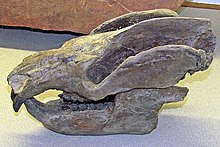
Synapsida is one of the two major clades of vertebrate animals in the group Amniota, the other being the Sauropsida. The synapsids were the dominant land animals in the late Paleozoic and early Mesozoic, but the only group that survived into the Cenozoic are mammals. Unlike other amniotes, synapsids have a single temporal fenestra, an opening low in the skull roof behind each eye orbit, leaving a bony arch beneath each; this accounts for their name. The distinctive temporal fenestra developed about 318 million years ago during the Late Carboniferous period, when synapsids and sauropsids diverged, but was subsequently merged with the orbit in early mammals.

Therapsida is a clade composing of a major group of eupelycosaurian synapsids that includes mammals and their ancestors and close relatives. Many of the traits today seen as unique to mammals had their origin within early therapsids, including limbs that were oriented more underneath the body, as opposed to the sprawling posture of many reptiles and salamanders.
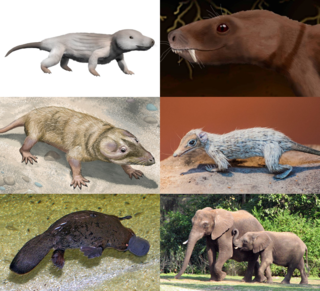
Cynodontia is a clade of eutheriodont therapsids that first appeared in the Late Permian, and extensively diversified after the Permian–Triassic extinction event. Mammals are cynodonts, as are their extinct ancestors and close relatives (Mammaliaformes), having evolved from advanced probainognathian cynodonts during the Late Triassic.
Oligokyphus is an extinct genus of herbivorous tritylodontid cynodont known from the Late Triassic to Early Jurassic of Europe, Asia and North America.

Tritylodon is an extinct genus of tritylodonts, one of the most advanced group of cynodont therapsids. They lived in the Early Jurassic and possibly Late Triassic periods along with dinosaurs. They also shared many characteristics with mammals, and were once considered mammals because of overall skeleton construction. That was changed due to them retaining the vestigial amniote jawbones and a different skull structure. Tritylodonts are now regarded as non-mammalian synapsids.
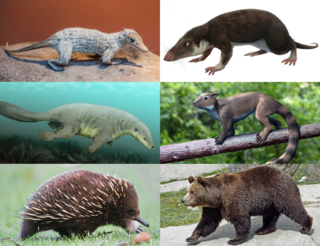
Mammaliaformes is a clade that contains the crown group mammals and their closest extinct relatives; the group radiated from earlier probainognathian cynodonts. It is defined as the clade originating from the most recent common ancestor of Morganucodonta and the crown group mammals; the latter is the clade originating with the most recent common ancestor of extant Monotremata, Marsupialia, and Placentalia. Besides Morganucodonta and the crown group mammals, Mammaliaformes includes Docodonta and Hadrocodium.
Sinoconodon is an extinct genus of mammaliamorphs that appears in the fossil record of the Lufeng Formation of China in the Sinemurian stage of the Early Jurassic period, about 193 million years ago. While sharing many plesiomorphic traits with other non-mammaliaform cynodonts, it possessed a special, secondarily evolved jaw joint between the dentary and the squamosal bones, which in more derived taxa would replace the primitive tetrapod one between the articular and quadrate bones. The presence of a dentary-squamosal joint is a trait historically used to define mammals.

The theriodonts are a major group of therapsids which appeared during the Middle Permian and which includes the gorgonopsians and the eutheriodonts, itself including the therocephalians and the cynodonts.

The evolution of mammals has passed through many stages since the first appearance of their synapsid ancestors in the Pennsylvanian sub-period of the late Carboniferous period. By the mid-Triassic, there were many synapsid species that looked like mammals. The lineage leading to today's mammals split up in the Jurassic; synapsids from this period include Dryolestes, more closely related to extant placentals and marsupials than to monotremes, as well as Ambondro, more closely related to monotremes. Later on, the eutherian and metatherian lineages separated; the metatherians are the animals more closely related to the marsupials, while the eutherians are those more closely related to the placentals. Since Juramaia, the earliest known eutherian, lived 160 million years ago in the Jurassic, this divergence must have occurred in the same period.
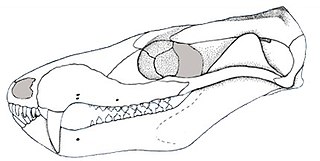
Brasilodon is an extinct genus of small, mammal-like cynodonts that lived in what is now Brazil during the Norian age of the Late Triassic epoch, about 225.42 million years ago. While no complete skeletons have been found, the length of Brasilodon has been estimated at 12 centimetres (4.7 in). Its dentition shows that it was most likely an insectivore. The genus is monotypic, containing only the species B. quadrangularis. Brasilodon belongs to the family Brasilodontidae, whose members were some of the closest relatives of mammals, the only cynodonts alive today. Two other brasilodontid genera, Brasilitherium and Minicynodon, are now considered to be junior synonyms of Brasilodon.
Dinnebitodon is an extinct genus of advanced herbivorous cynodonts of the early Jurassic period. It has only been found in the Kayenta Formation in northeastern Arizona. It closely resembles the related genus Kayentatherium from the same formation. It is set apart by differences in the dentition, while resembling in most other respects.

Kayentatherium is an extinct genus of tritylodontid cynodonts that lived during the Early Jurassic. It is one of two tritylodonts from the Kayenta Formation of northern Arizona, United States.

Prozostrodontia is a clade of cynodonts including mammaliaforms and their closest relatives such as Tritheledontidae and Tritylodontidae. It was erected as a node-based taxon by Liu and Olsen (2010) and defined as the least inclusive clade containing Prozostrodon brasiliensis, Tritylodon langaevus, Pachygenelus monus, and Mus musculus. Prozostrodontia is diagnosed by several characters, including:

Stereognathus is an extinct genus of tritylodontid cynodonts from the Middle Jurassic of the United Kingdom. There is a single named species: S. ooliticus, named after the Great Oolite deposits of England. A second species, S. hebridicus, was named after the Hebrides in Scotland, where it was found; it was synonymized with S. ooliticus in 2017.
Xenocretosuchus is an extinct genus of tritylodont therapsids from the Aptian Ilek Formation of Siberia, in the Russian Federation. The type species, X. sibiricus, is known only from dental elements, as is X. kolossovi, described from the Batylykh Formation in 2008. Some authors have treated these species as part of the genus Stereognathus, otherwise known from the Middle Jurassic of Britain, but this is rejected by other authors.
Montirictus is an extinct genus of tritylodonts known from the Early Cretaceous Kuwajima Formation of Japan. It was among the latest surviving tritylodontids, and is closely related to the earlier Xenocretosuchus from mainland Asia, and the Jurassic Stereognathus from the UK. It may be a species of the genus Stereognathus, but resolution of its affinities conditions upon the discovery of additional material.
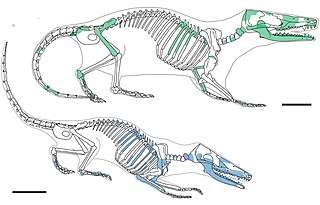
Borealestes is a genus of docodontan from the Middle Jurassic of Britain, first discovered on the Isle of Skye near the village of Elgol. It was the earliest mammaliaform from the Mesozoic found and named in Scotland. A second species and was later found in other Middle Jurassic sites in England, but is now shown to be a different genus. A new species, B. cuillinensis was named in 2021, also from Skye.

Pseudotherium is an extinct genus of prozostrodontian cynodonts from the Late Triassic of Argentina. It contains one species, P. argentinus, which was first described in 2019 from remains found in the La Peña Member of the Ischigualasto Formation in the Ischigualasto-Villa Unión Basin.
Fossiomanus is an extinct genus of tritylodontid mammaliamorphs from the Early Cretaceous of China. It includes one species, F. sinensis, which is known from a single nearly complete skeleton from the Aptian Jiufotang Formation. Features of its limbs and vertebrae indicate that Fossiomanus was adapted towards a fossorial lifestyle.
Michael Waldman is a British palaeontologist known for his work on fossil fish, mammals, and reptiles. He also discovered the globally important fossil site of Cladach a'Ghlinne, near Elgol on the Isle of Skye, Scotland. This site exposes the Kilmaluag Formation and provides a valuable record of Middle Jurassic ecosystems. During the 1970s he visited the site several times with fellow palaeontologist Robert Savage. The fossil turtle Eileanchelys waldmani was named after Michael in recognition of his notable contribution to palaeontology.

